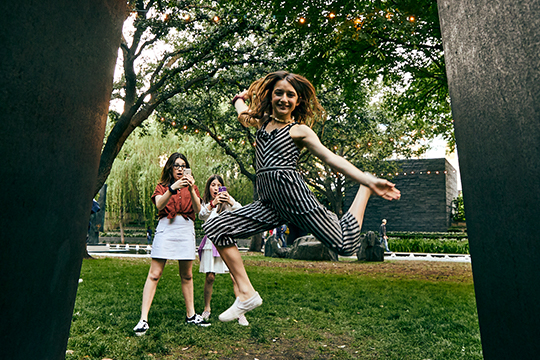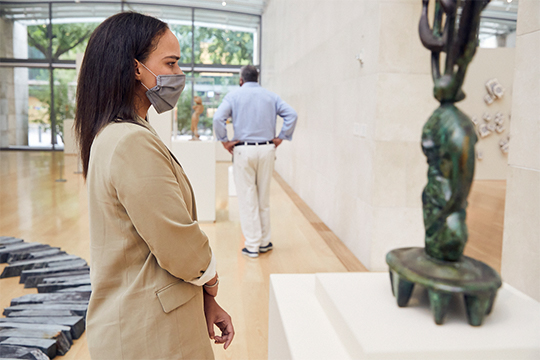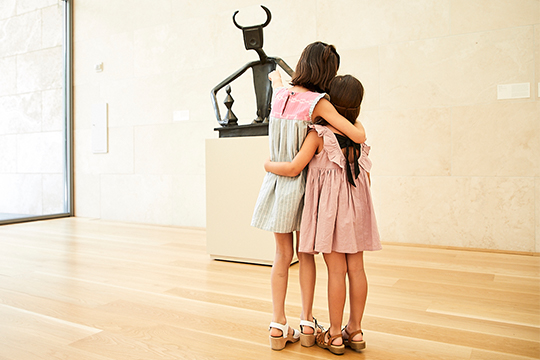This installation examines the legacies of Minimal art through the Nashers' support in the 1970s of artists including Siah Armajani, Martin Puryear, and Christopher Wilmarth, as well as the recent acquisition of a sculpture by Judy Chicago.
About Track 3: The Ends of Minimalism
In the early 1960s, a number of artists in different places began making sculptures that appeared starkly reductive. Created from simple, geometric, modular units and often fabricated using industrial processes and materials, such objects led observers to describe them in a variety of ways, but Minimalism soon emerged as the leading designation for what became one of the most influential developments in twentieth-century art. Artists associated with Minimalism, such as Donald Judd, Robert Morris, and Carl Andre emphasized the viewer’s visceral, direct experience with their work over its potential for self-expressive content, and they rejected modern art of the past as largely irrelevant to their concerns. While many of them had strong political beliefs, these were set aside in the creation of their art.
When Raymond and Patsy Nasher began collecting sculpture in the late 1960s, reactions to Minimalism were just beginning to coalesce among a new generation of artists—sometimes called Post-Minimalists—who bridled against its restrictions even as they drew inspiration from its example. As Patsy in particular became more interested in contemporary art in the 1970s, among the younger artists whose work attracted the couple’s attention were individuals wrestling with various facets of Minimalism’s legacy.
In the tensions between Minimalism and the ends to which artists have put it, the Nasher’s recently acquired sculpture by Judy Chicago plays a special role. With its geometric forms fabricated in aluminum and coated with vibrantly hued automotive paint, Rearrangeable Rainbow Blocks exemplifies essential qualities of Minimal art but proposes a subversive twist. Taking its modular logic to a singularly playful conclusion, Chicago pushed past Minimalism’s constraints by stating her sculpture’s perpetual susceptibility to reconfiguration, as if it were an enormous set of children’s blocks.
Audio Guides
Hear different perspectives on works in Track 3: The Ends of Minimalism.
Overview of The Ends of Minimalism
Maren Hassinger on Repetition in Minimalism
Joel Shapiro on Scale and Architecture
Remix
Discover more about sculpture. Find bonus content like video tours, inspiration playlists, and insights from curators, educators, and living artists.

Best of The Ends of Minimalism
Bringing together the greatest hits of Track 3: The Ends of Minimalism artists and themes.
Video: Judy Chicago Lecture Highlights

Deep Dive
Top recommendations to dig deeper into your favorite artworks and art trends.
Video: Artists Within Institution: Scholar Lewis Kachur speaks about Scott Burton
Video: Judy Chicago in conversation with Sarah Thornton: 3D Liberation
Video: Sheila Hicks and Giving Material Form to Color

Educator Picks
Suggested resources for families, educators, and the young at heart.
Teacher Resource: Joel Shapiro
Video: Night and Day Embroidery Art Activity with Artist Mylan Nguyen
Get Inspired

Listen to a music playlist inspired by artworks in Track 3: The Ends of Minimalism.
Listen on Spotify.
Explore the Collection
- Siah Armajani, Dictionary for Building: Door in Window #2, 1982-83
- Scott Burton, Untitled: Two Chairs, 1979
- Judy Chicago, Rearrangeable Rainbow Blocks, 1965
- Martin Puryear, Night and Day, 1984
- Joel Shapiro, Untitled, 1975
- William Tucker, Building a Wall in the Air, 1978
- Sheila Hicks, Menhir, 2018 (long-term loan)